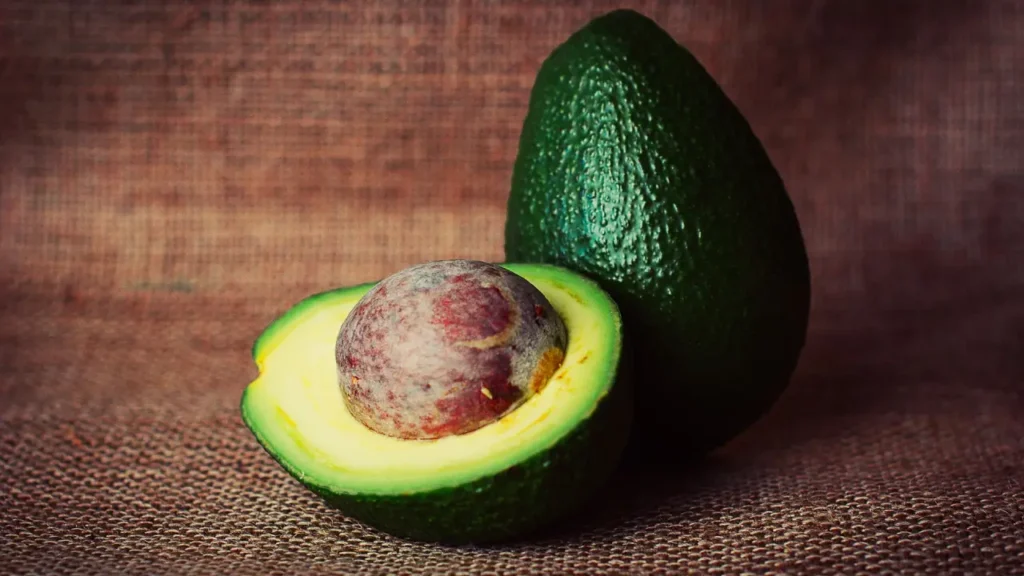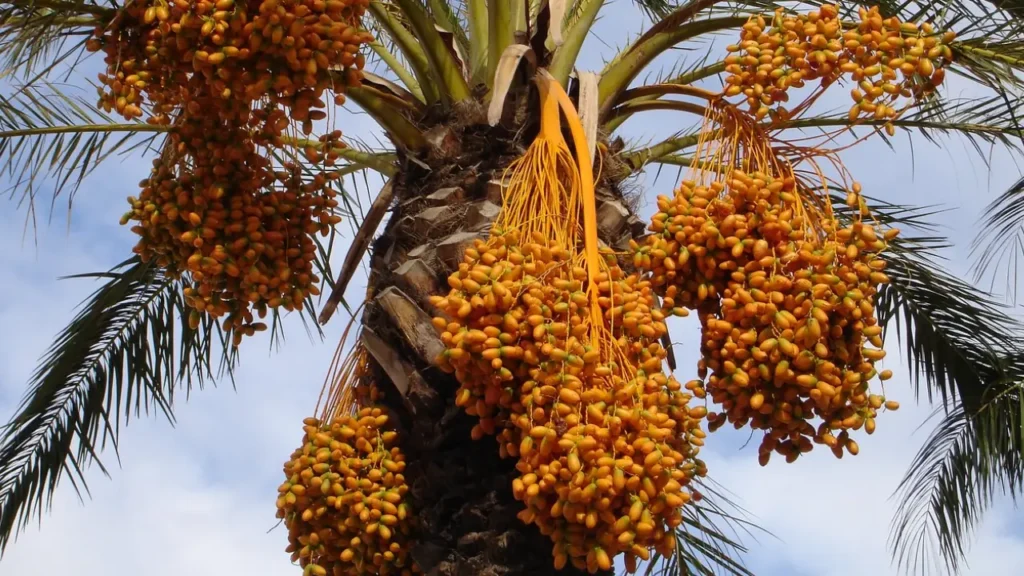Imagine a soft and sunny morning, the quiet leafing sounds, and the sweet smell of the strawberries floating through your garden. Home growing of strawberries is not simply limited to harvesting tasty fruits; this is actually a road traveled with learning, excitement and inspiration from your own piece of heaven.
Strawberries are not just a yummy dessert but also a chance to do something of your own, planting these in your own garden. Forget straining supermarket shelves for the tasteless and chemically modified produce, imagine picking fresh, naturally grown berries from your own fruit garden! In this article, we will see how to grow strawberries step-by-step. Therefore, let’s grab some tools and dig in to enjoy this amazing harvest!
Probably you are wondering, “Why strawberries?” They are delicious and good in vitamins and antioxidants. Strawberry farming is not very difficult and hence the most suitable option, regardless of your level of experience whether you are a beginner or professional in gardening.
Key Takeaways
- Strategic advice for beginner to advanced gardeners on cultivating strawberries.
- Personalized guidance for selecting the right strawberry variety for your region and tastes.
- Practical soil preparation techniques to give your strawberries the best start.
- Incorporating optimal sunlight and watering practices for healthy growth.
- Tips for harvesting and enjoying your homegrown strawberries at their peak of sweetness.
Table of Contents
Why Grow Your Own Strawberries?
The act of strawberry growing yields many benefits: the fruits do not only provide taste, but they also give a lot of joy at the moment of picking and eating the delicious fruits. Now, let’s uncover the importance growing strawberries in your own garden.
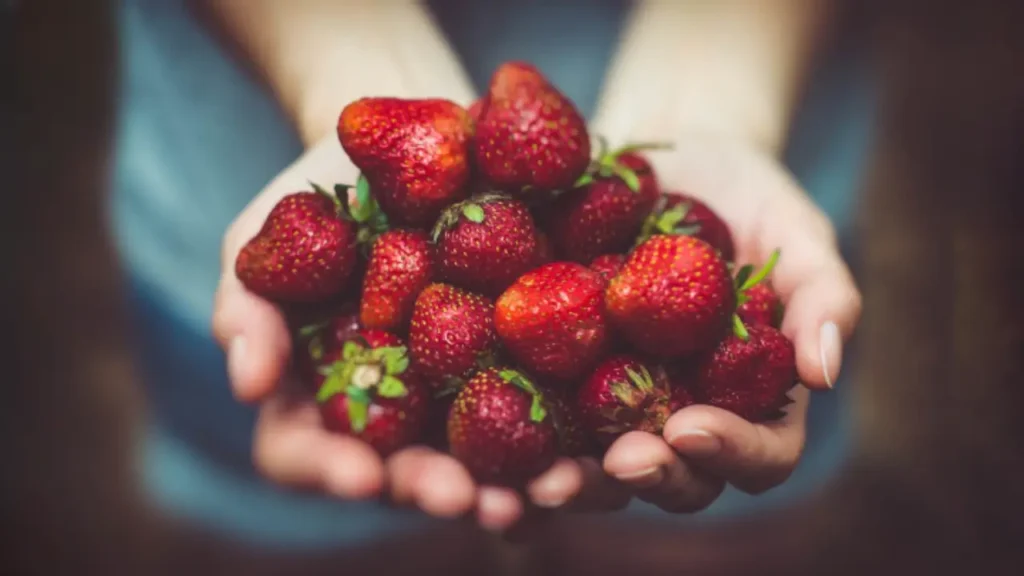
Quality Assurance
Growing strawberries at home gives you every power, as you choose the production culture. You have the liberty to choose whether or not you use chemical fertilizers, pesticides or herbicides, and any choice you make is to determine whether or not chemical is used in your strawberries. This way you can focus on going for organic and sustainable procedures which will further lead to the production of healthy and safe fruits for you and your family.
Freshness and Flavor
Tasting the strawberries that you have picked up from your garden, and the taste is simply unmatched. Not like the shop-bought fruits that may have traveled far distances from the farms and been through numerous processing stages, the strawberries from your backyard or nearby garden are intentionally rich in flavor and nutrients. That way, you can pluck them at the best of their season, guaranteeing their sweetness and juiciness.
Cost-Efficiency
The first expenses that should be taken into account are the cost of gardening supplies and the purchase of plants, but ultimately the cost of growing strawberry can be covered. With sure care and attention, the strawberry plants become frequent to bear multiple harvests within all length of the growing time. This plenitude ensures that you of perpetually getting new strawberries without needing to buy them all the time from the store.
Educational Opportunities
As a person, young and grown begins their journey in gardening, especially growing strawberries, the process is beneficial for both kids and adults, in terms of the educational opportunities that it presents, including learning how plants grow and about important life lessons that are involved in the cultivation of plants.
As a result, students can experience these practical demonstrations of the plant lives, balance of soil health, and principles of pest management as well as the requirement of environmental care. Getting involved in gardening enhances curiosity and persistence and, thus, it makes us more connected to and interested in our nature as well as our life-long learning and learning about the environment.
Health Benefits
The local strawberry sourced straight from the own garden not only tastes better but also offers many health benefits. Among the bounties of strawberries there are vitamins, minerals, antioxidants, and fiber that create healthy diet making us strong.
The habitual use of strawberries has demonstrated a decreased risk of chronic diseases like heart illnesses, diabetes and cancer of some types in many instances. Moreover, gardening as an exercise possesses a physical and psychological healing power that induces the reduction in the level of stress and perpetuates a good mood.
Environmental Impact
Growing strawberries at home presents the pro-environmental aspects in a number of ways. The carbon footprint size you reduce by cutting down on the unnecessary transportation and packaging associated with store bought produce is noteworthy. In addition to this, the sustainable gardening methods like compost, mulching and water conservation also help in minimizing the environmental pollution and promotes ecological diversity in your local area.
Choosing the Right Strawberry Varieties
Choosing the best strawberry varieties is of primary importance for a successful crop. As there are so many choices to pick from, climate, space availability and your personal taste matter a lot. Here’s an overview of how to choose the perfect strawberry varieties for your garden:
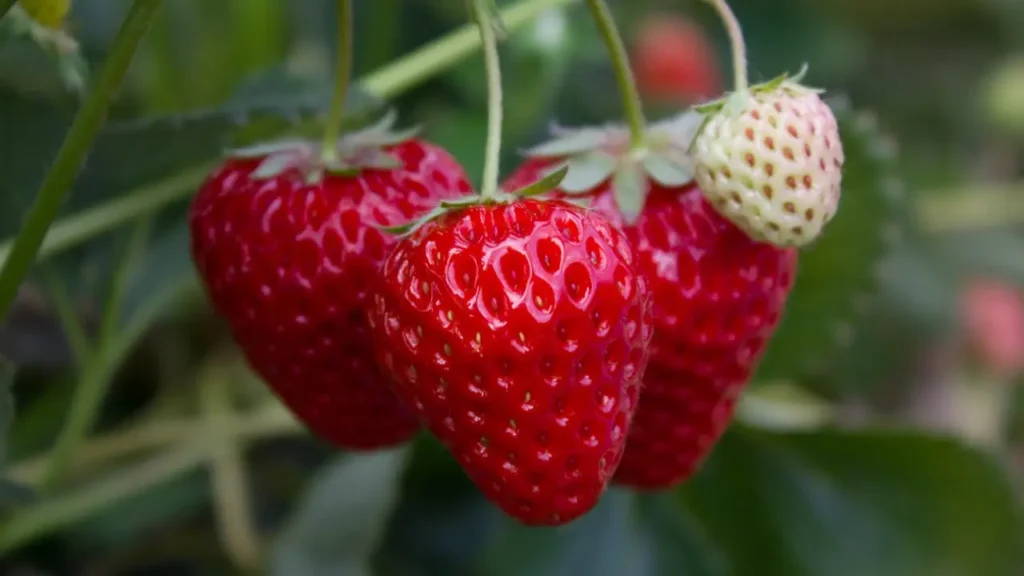
Climate Compatibility
In the process of choosing the species of strawberries for your garden in the US, you have to be sure to account for the diverse climate zones found in all the places of the country. Consequently, the United States encompass climate changes that range from the coolest maritime sections of the Pacific Northwest to the hottest and dryest deserts of the Southwest. We bring to you the main considerations for selecting varieties of strawberries with varied climatic zones as mentioned below.
Cool Temperate Zones (USDA Zones 3-7):
Varieties: Choosing very cold and hard varieties of strawberries that can be very strong enough to frost as well as the coldest temperatures typical of the northern regions. Examples that contain ‘Sparkle’, ‘Jewel’, and ‘Honeoye’.
Planting Time: Planting strawberries in the early spring, after the danger of frost being passed away, for allowing them to establish themselves before the beginning of a very hottest summer weather.
Mulching: Applying a bit of thick layer of mulch around those strawberry plants in late falls to insulate the soil and also protecting it against the winter destruction.
Warm Temperate Zones (USDA Zones 8-9):
Varieties: Opting for the heat-tolerating varieties of strawberries that can flourish in warmer temperatures as well as in the average winter temperatures. Considering varieties like ‘Chandler’, ‘Seascape’, and ‘Albion’.
Planting Time: Planting strawberries in the late summer to early fall or in the late winter to early spring for avoiding severe heat and cold anxiety.
Watering: Ensuring sufficient irrigation during the hottest, dry periods for preventing from dehydration and also maintaining soil moisture levels. Of mulch around strawberry plants in late fall to insulate the soil and also protecting it against the winter destruction.
Hot Arid Zones (USDA Zones 10-11):
Varieties: Select as day-neutral or heat-tolerant strawberry varieties, that have a good adaptation to adverse weather conditions, such as drought and high temperature. Types such as ‘Tribute’ and ‘Quinault’ are used in warm areas while ‘Seascape’ is one of the popular types of grape for hot climate.
Shade and Watering: Install by noon shade for the strawberries to keep them from receiving intense sun lights, use abundant water for the soil moisture shortage.
Mulching: Advise use of mulches in hot and dry regions round the plants to sustain soil moisture and inhibit evaporation.
Mild Coastal Zones (USDA Zones 9-10):
Varieties: Select of strawberry varieties that can and can perform satisfactorily when faced with maritime climates with temperature fluctuations throughout the year. The varieties such as ‘Seascape’, ‘Albion’, and ‘San Andreas’ are salt-tolerant and commonly used in salty coastal environments.
Planting Time: To have strawberries plated late summer through early fall, or late winter through early spring offers benefit of the cooler temperatures and stay out of summer heat stress.
Fertilization: Give regular fertilization once in a while with balanced elements so as to allow good growth and fruit production of the coastal areas.
Mountainous Regions:
Varieties: Choose strawberry varieties with good cold tolerance and adaptability to variable growing conditions. Varieties like ‘Earliglow’, ‘Allstar’, and ‘Ozark Beauty’ are suitable for mountainous regions.
Planting Depth: Plant strawberries slightly deeper in mountainous soils to protect against temperature fluctuations and ensure proper root establishment.
Protection: Provide frost protection during late spring frosts and early fall freezes to prevent damage to strawberry blossoms and fruit.
Day-Neutral vs. June-Bearing vs. Ever bearing
However, strawberries are generally divided into three main classes because of fruiting habits,
June-Bearing
These varieties develop just once in the spring in the late season mature strawberries. They are perfect for locations with a clearly pronounced season and that’s what gives them big and juicy flavours.
Ever bearing
Changing variety of strawberries can produce several smaller harvest times per year, blending into spring, summer, and fall. They provide good crop sequence spanning across a long season for gardeners who would like to have a continuous harvest.
Day-Neutral
The hybrid variety of day-neutral strawberries produces fruits with little or no environmental variations such as weeding, bee pollination, weed control, amongst others. Additionally, with this type, the crop can be cultivated consistently all the year long without considering day length. They provide grower with the possibility of adapting their crop production timing and also are suited for various types of climates.
Taste and Texture
Keep it in mind that you should select a variety of strawberries that meet your taste preferences. Several cultivars have a perfect sweetness, and also others create your mouth watering due to their tartness. Also pay attention to the texture of berries whether you like firm, crisp berries or smooth and delicious ones as you go.
Size and Appearance
Varieties of strawberry differ in size, shape and color of not only the fruit but also the plant. Choose varieties which you find more appealing in terms of their color and which you intend to prepare in the kitchen. While some varieties are perfect for eating off the trees in large unmixed berries, others have berries that are better for processing into jams, jellies or preserves.
Disease Resistance and Vigor
Choose strawberry types that will be able to resist typical diseases and pests of your region. Consider planting resistant and tolerant varieties. Such resistant varieties of plants are a lot less susceptible to various fungal infections, for example, powdery mildew and rot, resulting into healthy crops and greater yields. Furthermore, choose the vivid varieties that show robust growth styles and overwhelming fruit production.
Available Space
One of the things you should consider before you can choose a variety of strawberry is the space that is available in your garden or growing area. Some are proportionally smaller while others have the spreading growth habit and so are good for container gardening or for small raised beds, but others require more extensive planting areas in order to thrive.
Personal Recommendations and Reviews
Get recommendations from the local nurseries and garden experts as well as other passionate gardeners (i.e neighbors) with working knowledge of the Eco-system in your region. Personal experiences and online reviews may help decide about the feasibility of different strawberry varieties.
By considering these factors and conducting thorough research, you can choose the right strawberry varieties that align with your gardening goals and preferences.
Preparing Your Garden for Strawberry Planting
When gardening season is around the corner, checking the conditions of the outdoor space takes first place to ensure it is fully ready for strawberry plants to be planted. Setup of the garden beds correctly not only provides a possibility for a higher yield for the growing season but also eliminates most of the common obstacles to growth. The ideas given below will show techniques to carefully manage soil, come up with plans for strawberry beds, and get the equipment and tooling to support the systems.
Preparing the Soil
Proper soil preparation for growing strawberries in the USA is a central element in our race towards ultimate success of the crop. Determine the soil pH level and the soil’s fertility to assess if it is good enough for strawberry growing.
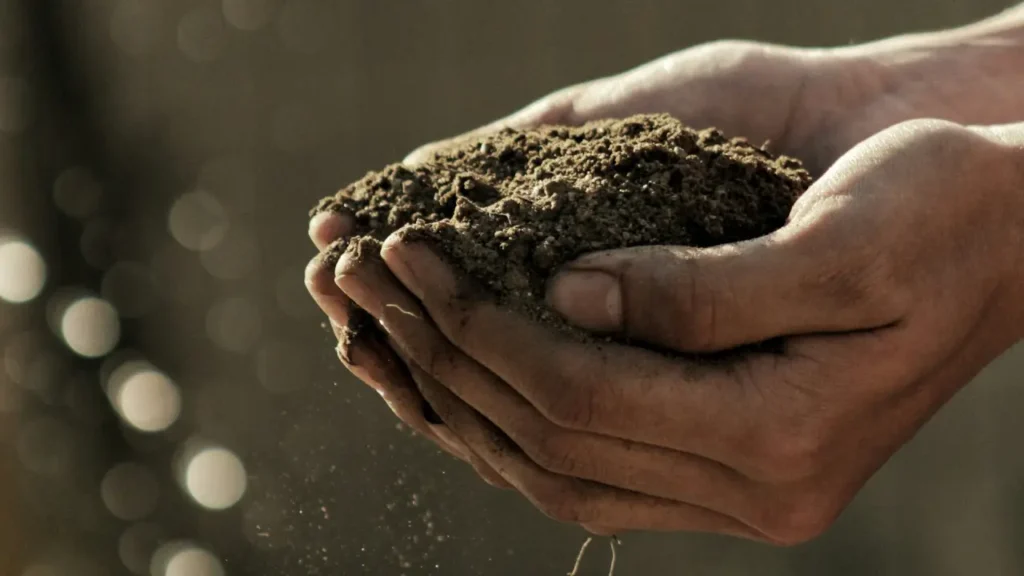
Most strawberry varieties grow better in more or less acidic soil with a pH range and between 5.5 to 6.5. Adjust your soil with the organic matter which could be compost, well-rotted manure, or peat moss to improve composition, drainage, and fertility of the soil.
Add the amendments into the top 6-8-inch strata of soil by using a fork or tiller. Also, see to it that water does not stagnate by ensuring that the water logging doesn’t occur since it slowly kills roots and leads to fungal diseases.
This step is important, because you need to make sure that there is enough of nutrients available for your strawberry plants to growth.
Layout and Design Considerations for Strawberry Beds
The second major thing in the preparation process of the landscape is planning your strawberry spot with sufficient interest. A traditional single file row layout will work very well too. The other interesting option might also be raising the beds, or even constructing a multi-storied planter to maximize your space and facilitate drainage.
Don’t forget to leave enough distance between the rows if you’re planning to manage and extract the yield easily. A good plan when you sow the strawberry bed will result in a suitable accessibility and yield.
Equipment and Tools Necessary
The availability of appropriate gardening tools and equipment to hand saves you a lot of time in preparing the gardening tools. Make the list begin with basic hand tools like spades and digging fork which are for the purpose of soil turning and aeration.
The basic components for the measuring soil acidity are an electronic pH meter, or a soil test kit. When you are refreshing your soil levels or constructing a raised garden bed, a wheelbarrow is a handy tool to consider. Get your gardening gloves ready not to forget them while you work to protect your hands.
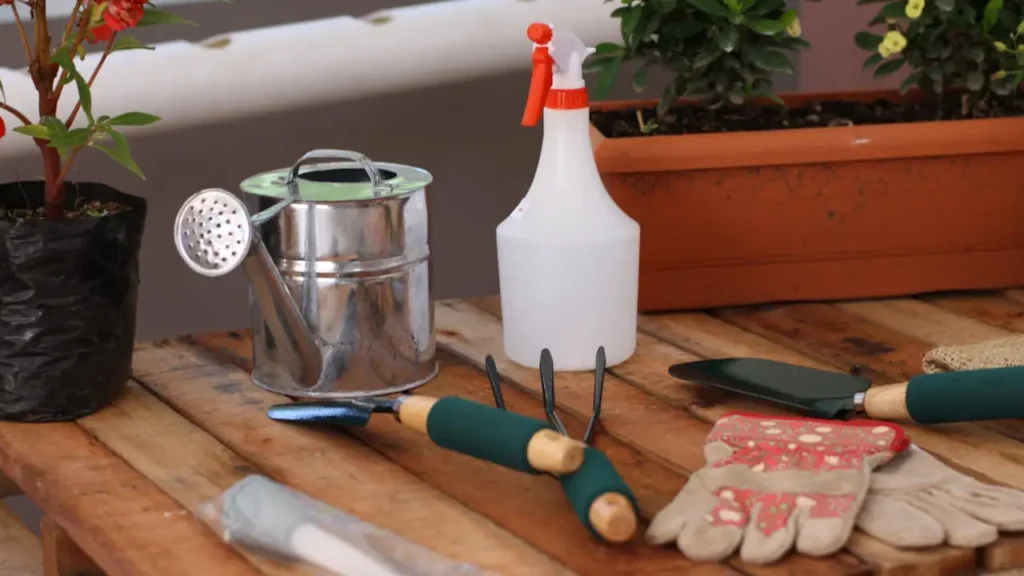
- Spade and Fork: For turning the soil.
- Cultivator or Hoe: For breaking up soil clumps and weeding.
- Soil pH Tester: To accurately determine soil acidity.
- Wheelbarrow: For transporting soil and amendments.
- Gardening Gloves: To protect your hands during work.
- Irrigation Supplies: Drip lines or soaker hoses for efficient watering.
Planting Strategies for Maximum Yield
The biggest step towards a productive strawberry garden lies in applying the knowledge of planting techniques. through the process we’ll discuss the timing to spacing, covering some strategies to be followed by the strawberry planting season that makes your harvest bigger.
The purpose of optimizing your planting strategy for strawberries is not only to increase the current harvest; your goal should be the health of the plants so that they are vigorous and will be able to survive the seasons.
Best Time to Plant Strawberries
The exact time frame for planting strawberries varies considerably between regions and climate characteristics of the place. In the US, the strawberry planting period differs for those regions that are warmer because they plant in late fall to early winter and ones that are colder for using the early spring as the best planting period. The aim is to plant strawberry runners or plants grew stronger roots for a robust foundation before the heat of summer or the growing season’s peak.
Spacing and Depth Techniques
Now, when your soil is already prepared, it is a good time to plant the strawberries. Make your location permissible by ensuring it receives at least 6 – 8 hours of direct sunlight per day.
Then decide if the form is bare-root crown or potted plants and ensure that they are strong and healthy without any diseases. Make planting holes that are slightly larger than the plant’s root system, and focus on placing them at the appropriate depth with the crown just above the soil level.
A vice-regal principle, which can be applied to strawberries almost without exception, is to keep strawberry plants 18 to 24 inches apart with a minimum 36 inches between rows. This way was organized to avoid problems with overcrowding and stuffy corridors.
Companion Planting with Strawberries
One way to organically increase your garden’s productivity can be by implementing the companion planting technique that strongly stimulates natural pollinators, beneficial insects, and birds. It is a sort of a gardening technique that goes way back in the history of mankind and it is based on the idea of helping each other to improve the product of the soil.
Grazing alongside your strawberries with some reliable partners not only allows you to achieve the most with limited space but also could greatly enhance the health of your strawberry plants. Here are a few companions known to be beneficial.
| Companion Plant | Benefits |
|---|---|
| Borage | Attracts pollinators and deters pests. |
| Thyme | Repels worms and enhances flavor. |
| Garlic | Fights off fungal diseases. |
| Spinach | Provides light shade and shares space efficiently. |
| Marigold | Deters nematodes and beautifies the garden. |
By selecting the right companions, you can foster a supportive community of plants that ward off pests, attract beneficial insects, and create a thriving ecosystem that supports a bountiful strawberry yield.
Maintenance Tips for Healthy Strawberry Plants
Empowering your strawberry plants to flourish starts with consistent and dedicated strawberry plant care. Integral to garden maintenance, these tasks bolster the foundation for healthy strawberry growth. A well-maintained strawberry garden can indeed turn into a bountiful haven, brimming with juicy, sweet berries. Let’s explore the key approaches to nurture and sustain vigorous strawberry plants.
- Weeding: Frequent uprooting of weeds ensures that resources like nutrients and water are not lured away from main crops.
- Mulching: An organic layer of mulch regulates the soil temperature, conserves moisture, and keeps the berries free from soiling acts.
- Runner Management: Remove any runners that are in excess. Put your focus on one fruit instead of several off them. This directs the plant to put its energy into fruit production.
These simple yet effective steps are pillars for healthy plant development, which lead to the lush yields every gardener aspires to achieve.
| Maintenance Activity | Benefits | Frequency |
|---|---|---|
| Weeding | Promotes better access to nutrients and decreases disease risk | Bi-weekly or as needed |
| Mulching | Controls soil temperature, preserves moisture, deters pests | Annually or seasonally |
| Runner Management | Encourages bigger and better quality berries | Throughout growing season |
| Fertilization | Ensures the delivery of essential nutrients | During growth periods, as indicated by soil tests |
| pH Monitoring | Maintains optimal soil conditions for absorption of nutrients | Seasonally or when new plants are set |
The soils of strawberries are just as important as mulching does the following: it holds soil moisture, keeps the soil warm and provides a reduced weed growth environment. Spread an organic mulch covering of 2 – 3 inches in deep around plants. Use straw or pine needles or shredded leaves for this. Give much consideration so as the mulch is spread evenly enough and at a distance away from the crown of the plants so as the plants crown not rotted.
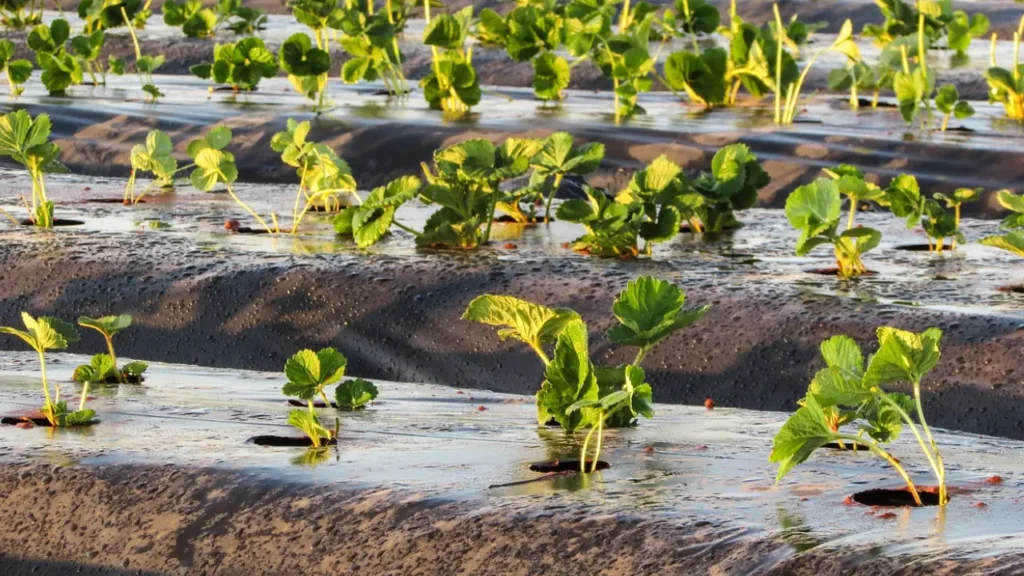
As the growing season progresses, keep adding and refreshing the mulch to ensure required materials supply. Besides that, take good care of the moisture content in the soil and change your watering schedule depending on the conditions of the weather, be in the hot and dry days.
Remember, the vigor of your strawberries can be directly linked to the consistency and attention given to these regular maintenance practices. A gardener’s care reflects unmistakably in the health and abundance of their strawberry yield.
Pest Management in Strawberry Gardens
Effective garden pest control begins with the understanding of strawberry pests, a crucial aspect for anyone passionate about homegrown berry gardening. In this section, we discuss comprehensive strategies for organic pest management, incorporating practices that support a healthy and productive strawberry patch.
Organic pest management methods are not only about the fact of pest killing but also about creating such a preconditions where longer plants can grow and suffer because of mild pests problems. The application of some techniques like healthy insects, good sanitation, crop rotation and installation of barriers can help to control the garden pest. Through the practice of these Eco friendly techniques, the gardeners will have the opportunity to maintain their safe bounty completely from the threatening pest.
- Start the section on the most widespread strawberry pests, namely, spider mites, aphids, and slugs.
- Preventative measures of row covers and promotion of desirable insects.
- Treatment methods such as applying organic insecticides that are based on neem oil and insecticidal soap on the plants as a preventative action.
- Integrated Pest Management (IPM) approaches could be evolved by using cultural, physical, biological, and chemical tools together.
Implementing garden pest control methods requires patience and consistency. Regularly inspecting plants for any signs of damage, timely application of organic treatments, and fostering a diverse ecosystem within the garden can all deter pests while promoting the health of the strawberry plants.
“I’ve always believed that prevention is better than cure when it comes to pest management in my strawberry garden. By focusing on natural and organic methods, I’ve managed to maintain a vibrant, pest-free patch that yields plump, juicy strawberries every season.” – Insights from an experienced gardener.
In summary, the fight against strawberry pests can be won through diligence and an understanding of ecological balance within your garden. Organic pest management is a beneficial approach that safeguards both your strawberries and the environment.
Disease Prevention for Robust Strawberry Plants
Maintaining the health of strawberry crops is a cornerstone of productive gardening, where understanding strawberry plant diseases is as crucial as the measures taken for disease prevention and organic disease control. Fostering robust strawberry plants is heavily reliant on sound horticultural practices that not only address issues as they arise but proactively prevent them.
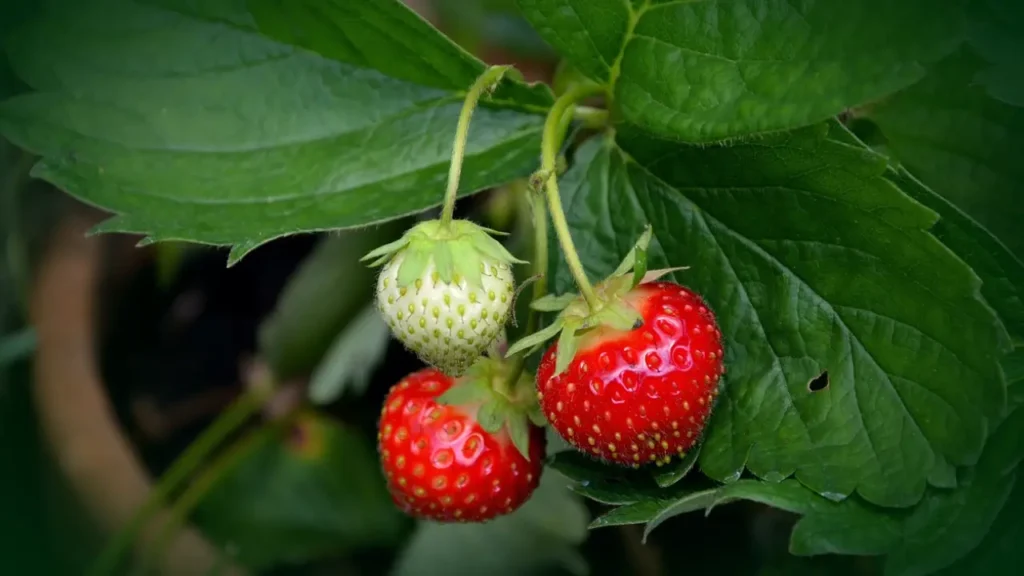
Common Strawberry Diseases
It is through a range of microorganisms that strawberry crop’s health can be compromised. The most common ones are fungal infections b. e. gray mold (Botrytis cinerea), leaf spot (Mycosphaerella fragariae) and verticillium wilt (Verticillium spp.). These diseases can destroy the whole crop if not checked timely and therefore, identification and treatment of them as early as possible are imperative.
Cultural Practices to Prevent Disease
To avoid the risk of contracting any diseases, gardeners are advised to come up with a list of cultural practices which are responsible for lowering the risk. For instance, activities like crop rotation, a well-planned site that allows for air flow, and possible methods like removing diseased plants can help significantly reduce the occurrences of disease. Other than that, the usage of disease-resistant varieties and good soil management practices that would include the maintenance of the right pH level and promotion of drainage are often used towards fighting these pathogenic assaults.
Organic Solutions for Disease Control
If diseases do enter the Eco-system of organic farming, using the organic solutions on set those sustainable agricultural practices. Compared to the use of organic, botanical fungicides which include neem oil and sulfur based creams can bear fruit without side effects of synthetic chemicals. Including natural pest control, (like microbes that take over harmful pathogens) as well as building a healthy and resistant garden ecosystem is vital.
| Disease | Symptoms | Organic Control Method | Preventive Practice |
|---|---|---|---|
| Gray Mold (Botrytis cinerea) | Grayish-brown fuzzy growth on fruit and flowers | Apply Bacillus subtilis-based formulas | Improve air circulation, avoid overhead watering |
| Leaf Spot (Mycosphaerella fragariae) | Purple or red spots on leaves and stems | Use copper-based fungicides sparingly | Remove affected foliage, sanitize tools |
| Verticillium Wilt (Verticillium spp.) | Yellowing leaves, plants wilt despite water | Enrich soil with high-quality compost | Plant resistant varieties, ensure proper drainage |
Fertilization Techniques for Thriving Strawberries
Making strawberries more productive through efficient strawberry fertilization starts with the knowledge of specific nutrient requirements of these plants appreciated to the fullest. Exacting nutrient management is not only about feeding the plants; it’s about proliferating a fertile soil ecology to support sturdy growth and juicy, sweet berries.
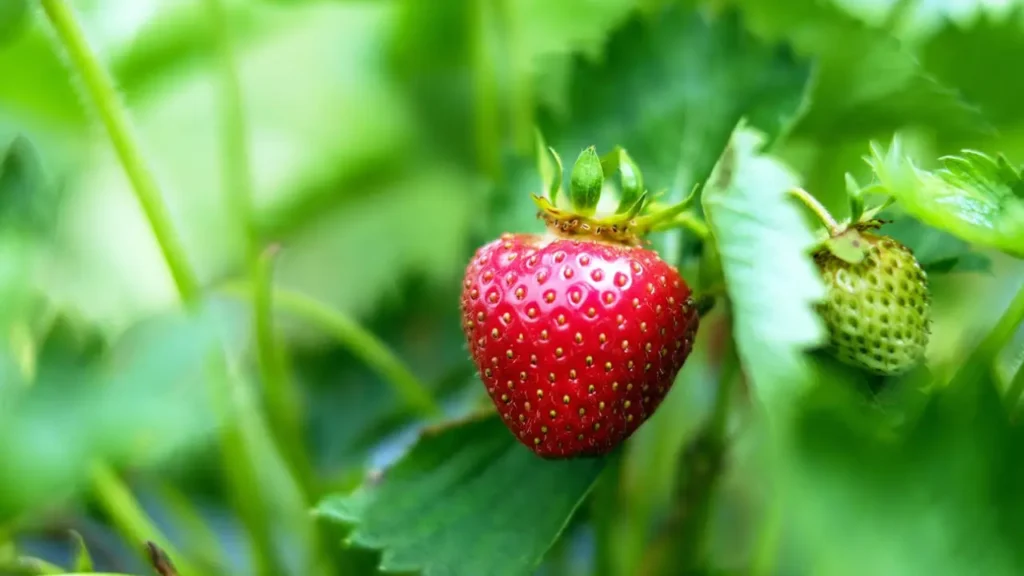
With organic fertilizers slow release nutrients are most advantageous. This is not as likely to be leached away and rather more likely to help the plants throughout their whole growing season. However, looking at organics is not only about choosing organic, but it is also about choosing the right varieties for your strawberry patch.
Please bear in mind that too much of the good thing can be harmful though. Excessive leaf growth due to over fertilization can in return result to diseases and pests invasion.
In order to achieve the strong fertilization strategy, conduct the fertilization program in that direction with soil nutrient tests. These results will also tell your exactly what is missing in your soil and what is needed to make happy strawberries. From the nitrogen to the potassium, get to know the essential components that build your soil fertility.
- The nitrogen balance is really vital, therefore, any under or over application is not allowed as it can affect the plants for not blooming or excessive growth (as it may be) of the leaves.
- Phosphorus is necessary in the stages of blooming and fruiting when crop perform optimally.
- Potassium, on the other hand, is a primary positive ion that impacts plant health in general, including taste and resistance to diseases.
Timing is everything when it comes to fertilizing strawberries. Fertilization should coincide with plant development stages to support their growth:
- Early Season: Fertilize for an intensive root development and leaves expansion.
- Pre-Flowering and Flowering: Using the fertilizer which is rich in phosphorus, ensure of the good flower set phase.
- Post-Harvest: The balanced fertilization serves as a recovery method for plants and further sets the stage for the plants to be prepared for the next season.
Keep in mind to consider the instructions of National Institute of Food and Agriculture as well as the region specific regimen for the type of crop and soil.
Here’s a helpful framework for your fertilization plan:
| Development Stage | Nutrient Focus | Fertilizer Type | Application Timing |
|---|---|---|---|
| Early Growth | Nitrogen | Composted manure or a balanced N-P-K blend | After planting and again in late August |
| Pre-Flowering | Phosphorus | Bone meal or rock phosphate | One to two weeks before blooming |
| Fruiting | Potassium | Green sand or sulfate of potash | As fruits begin to form |
By perfecting your strategy for strawberry fertilization and using appropriate organic fertilizers, you care for the plants and the entire live soil, and thus, in return, you savor the plenteous and mouthwatering strawberry harvests.
Irrigation Systems for Adequate Watering
Making sure that your strawberry plants get proper watering is the very foundation of years lift production. In the following part, we’ll examine the variety of irrigation techniques that are implemented in order to reach water usage effective and maintain good health of the plants. What you will benefit from the detailed pros and cons of the water systems, which is as well as the watering systems that suit the climate are crucial parts of beneficial strawberry cultivation. Also, we offer advice on water saving that assists in the most sustainable growth.
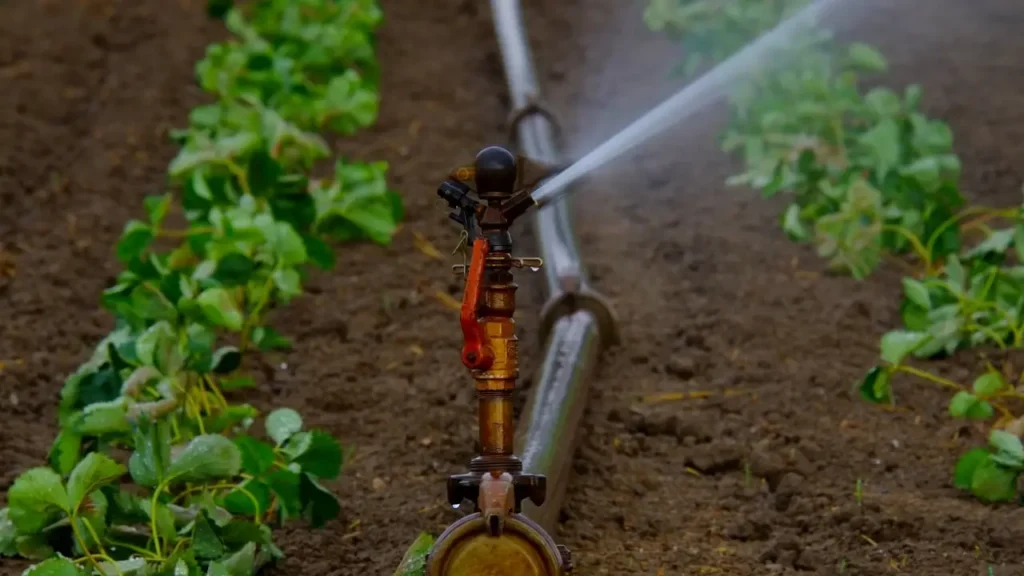
Choosing the Right Irrigation Method
Strawberries farm irrigation system selection plays a central role, and the choice relies on multiple factors: size of the plot, local climate, and water resources. The leaky systems of subsurface drip irrigation are highly appreciated as water does not only go straight to the root zone and therefore the losses of water by evaporation are also decreased by a lot.
Moreover, you should also make use of overhead sprinkles you can apply as well; however, such practice showcases more water wastage, and the risk of getting the disease if the leaves remain wet. This is very crucial when applying water close to the root zone by targeting the ordinary water loss and promote lateral rooting that uses less water but helps in growth.
Watering Schedules for Different Climates
You have to determine the watering schedule that suit you your specific climate zone, taking into consideration that different strawberry plant types have unique water requirements. In the area of dry weather, the frequent watering must be practiced to provide compensation for high evaporation rates, whereas, in the cool, moist temperature area, the water demands may be quite reduced By following the climatic schedule of your strawberry plants through monitoring their soil moisture levels, you can really update their times of irrigation so that they receive sufficient quantity and at the right time.
Conserving Water while Growing Strawberries
Nowadays, conservation becomes a necessity in gardening and there are multiple solutions to conserve water when irrigation of strawberries is involved. Studies have shown that mulching is one of the frequently used methods to prevent soil moisture wastage and cut on water usage. Moreover, the fact that morning hours irrigation reduce the water loss by evaporation is also paramount. Adopting rainwater collection system can also be a good Eco-friendly approach for your home as a source for your strawberries to shine, together, with maintaining the principles of sustainable water management.
Pruning and Thinning
In strawberry production, pruning and thinning are two extremely important practices which are done for proper care of healthy and fertile crops. Such matters are responsible for air circulation improvement, disease incidences’ reduction and to the full and proper establishment of fruit. Here’s how to prune and thin strawberries effectively:
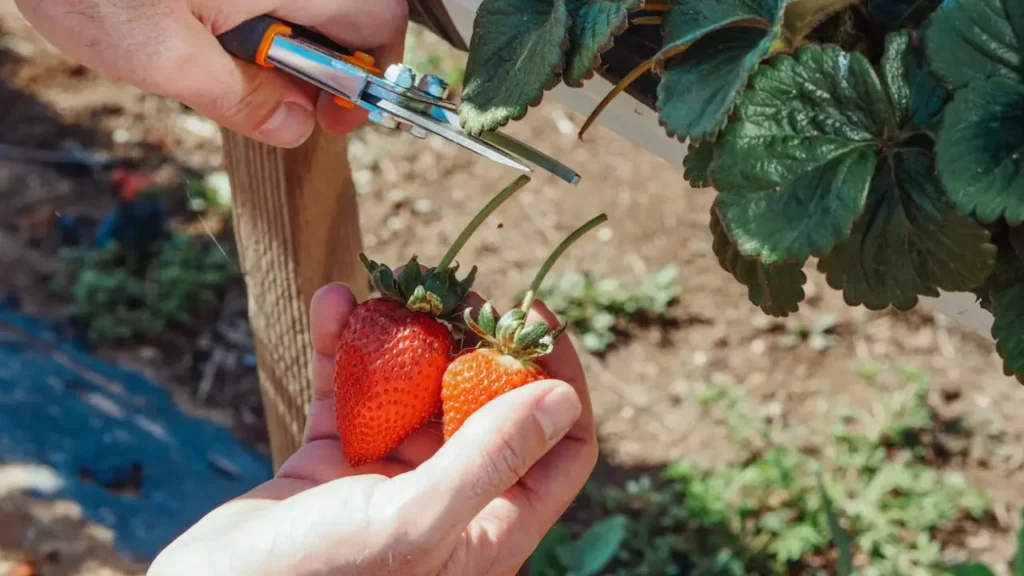
Spring Pruning:
Start in early spring by removing any dead, injured, or sick leaves from the strawberry plants with a sharp, clean pruner. Prune the leaves right at the base of the plant so as to check the spread of the disease and to stimulate new growth.
Prune congested or strawberry dense areas by choosing to remove extra daughter plants or runners in an area. Try to keep a horizontal distance of 6-8 inches between plants to allow for the plants’ access to fresh air and sunlight.
Flower Removal:
To get a strong strawberry plant, cut off the first flowers that appear on strawberries planted when they were young or are newly planted. It helps the plants to focus their energy in tapping deep into the soil for good root systems rather than indulging into yet bear fruits.
Remove any blooms that come in your first few weeks of time after planting to enable the plant to concentrate its energy on vegetative growth.
Runner Management:
Monitor the strawberry plants throughout the season to notice the formation of runners being the long, trailing stems that produce new plantlets at their tips as they grow. Remove some extra runners so the roots remain strong and do not become crowded.
Let a couple of healthy horses remain to ensure the procurement of new plants the coming year. Place these runners in the places where they are supposed to be ran across the strawberry bed and in containers filled with potting soil.
Summer Pruning:
When the main strawberry fruit bearing season is over in early summer, cut off the older leaves that have finished fruiting so that the new leaves can develop well. Tear off any yellowish or sickly leaves to keep plant healthy.
Thin out the last remaining runners or daughters to prevent your strawberry patch from getting overcrowded. Concentrate on overhead canopy being open and well-ventilated to cut on disease pressure and enhance fruit quality.
Fall Cleanup:
Perform the third and final round of pruning and thinning in late summer to fall, in order to help the strawberry plants go into the dormancy stage. Remove the remaining dead or sick foliage and thin out of the bed, so it is open enough to provide air and remove the chance of winter damage.
Overall Maintenance:
The monitoring of strawberry plants during the entire growing season is necessary to prevent any diseases and insects infestation as well as in case of nutrient deficiencies. Engage promptly in any case to minimize the spread of the issues; it could lead to the compromise of the plant health.
Keep the strawberry bed clean and tidy by removing weeds, debris, and plants that are decaying to get them out of the plantation. So, people won’t have to worry about complicated diseases and pests problems and keeping the farm neat and clean will be easy.
Through the use of pruning and thinning practices, the growth condition of the strawberry will be promoted, the fruit quality will be improved, and ultimately, the strawberry harvest has a strong chance of maximizing Through good care of your strawberry plants, they will yield you a lot of tasty berries that will last last season after other and harvest after harvest.
How to Grow Strawberries Using Organic Methods
Strawberries are grown all over the world, and they are so sweet, which attracts many growers. Among those who really appreciate the uniqueness of these highly valued fruits, a sustainable living is perfect. Being a sustainable gardener is the chance for you to participate in the production in addition to the conservation of the best flavors from your fruits. Here, we’ll cover the key stages for a pesticide-free strawberry farming practice that does not depend on hazardous artificial substances so the garden and the planet can produce a healthy environment.
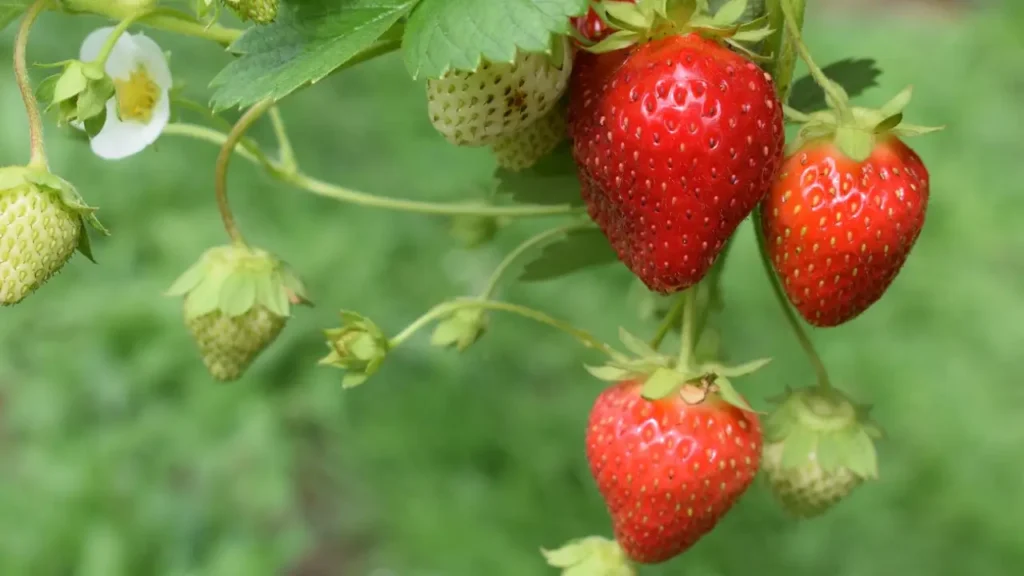
Success of strawberry field in an organic way is all about soil as a starting point. The biologically active natural soil amendments like compost, aged manure, and leaves are not only enriched in nutrients but also improve its structure and water retention capabilities. Knowing soil’s pH is the key—strawberries grow best in a slightly acidic environment, normal pH being between 5.5 and 6.5. Applying your soil amendments in harmony with these principles will enable your strawberry field to flourish.
- Organic Pest Control: Promoting useful insects and realizing natural defense like neem oil and diatomaceous earth will be able to lower the number of pest.
- Companion Planting: Plant bee-friendly plants such as borage, thyme and marigold along the strawberry row to encourage pollinators and remove the harmful pests.
- Weed Management: Besides, choose the mulching method out of the two i.e, straw or wood chips to prevent the weeds from germinating yet keeping the soil moist. Regular hand-weeding also prevents weed competition.
On the other hand the balance of an ecosystem with ecological gardening is crucial. Provide habitats for natural predators like birds and ladybugs by establishing a birdhouse or not doing an extreme manicure in your plantation. These predators will be managed by the nature by itself for the issue, therefore intervention will be less required.
In addition, the water management is one of the key factors that must be considered for the Eco-friendly strawberry farming. Drip irrigation systems deliver water to the base of plants, and this why these systems curb the wastage of water and shoulder off of the leaf diseases. Harvesting rainfall and reserving it for periods with smaller rainfall will be another way of respect for the environment and an additional way for the organic strawberries to survive.
Keep in mind, that sustainable gardening is not all about excessive use of chemicals but it goes beyond that to create an environmental where the ecosystem works in synchronization. Whether you are an urban gardener, with a breeze-way balcony or a countryside homesteader with a field as the large as it can be, the principles of organic farming can be adapted. By following these principles, the hard work that goes into producing an organic strawberry crop which will reward you with a fresh crop of well-taking care of strawberries, which will be delightful when tasted as well as responsible to grow.
Harvesting Strawberries for Peak Flavor and Freshness
Picking strawberries is finally here and choosing the ripest strawberries with the juiciest yield is imperative for the best aroma and taste. The harvest season normally starts in late spring to early summer, when the strawberries exhibit their vivid and even-red skin, which is an indicator of strawberry ripeness. For a sweet harvest that would make you proud, let’s explore the signs that show your strawberries are ready to be disconnected from their stems, and find out how to do this.
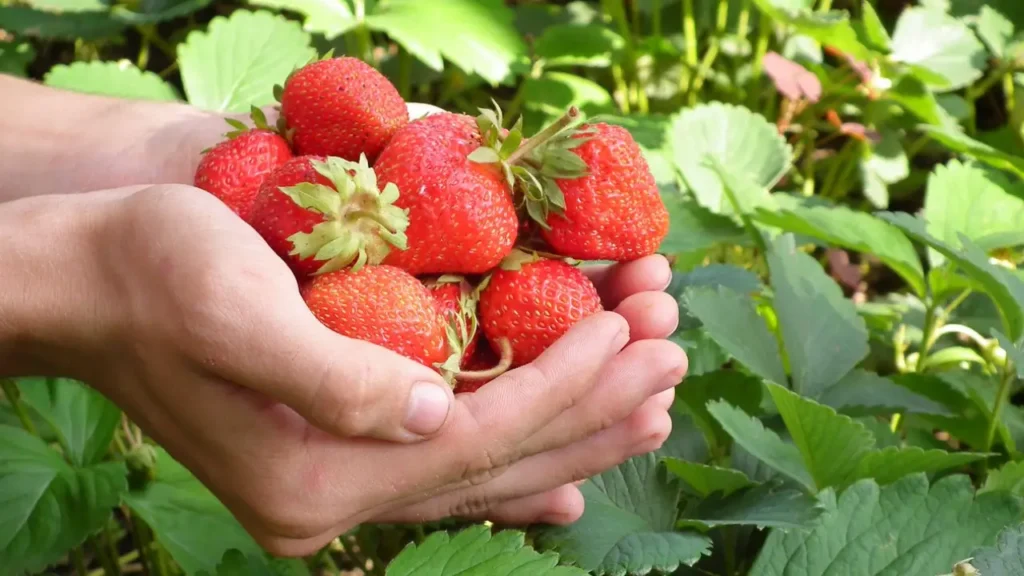
Indicators of Strawberry Ripeness:
- Bright red color extending from the tip to the area near the stem
- Plump and firm to the touch, yet yielding when gently squeezed
- A fragrant aroma that is sweet and inviting
Harvesting Techniques for Quality:
- Get the stem close by a berry on the forefinger between the finger nail and the thumb, and then pinch them off cleanly, avoid damaging the plant or the berry.
- Berry picking is the best done in the morning avoid the hottest part of the day that can cause the fruits to lose their rigidity and make them spoil faster after harvesting.
- Use a container which is not deep so that you can place the berries without damaging their coating and to obtain a quality product.
Note that being picked strawberries no longer get ripen and therefore it so important to harvest at proper stage for it to be right balance of sweetness and acidity.
When you harvest strawberries, it becomes an intricate combination of nature and timing, because they can be fully ripe for a maximum of one to three days. Regular visits to your strawberry garden will gradually become your favorite ritual, and certainly the most rewarding part of this spring. They will bring to the table the perfection that only Mother Nature can do. Living this reveling is the way to go ahead, and you will experience its beauty in reality. Lastly, it comes right down to the ability of enjoying the fruits of your own labor in your comfort of your garden.
Post-Harvest Care and Storage of Strawberries
The way of the strawberry from the garden to a table does not only end at the moment of harvesting. To ensure that the magnificent taste of strawberries is available for longer time spans, those methods of care after harvest and storage that are proper must be applied. The following procedures will preserve the quality of your fruit crop and the berries will stay fresh for extended period of time to delight your guests during other seasons besides picking season.
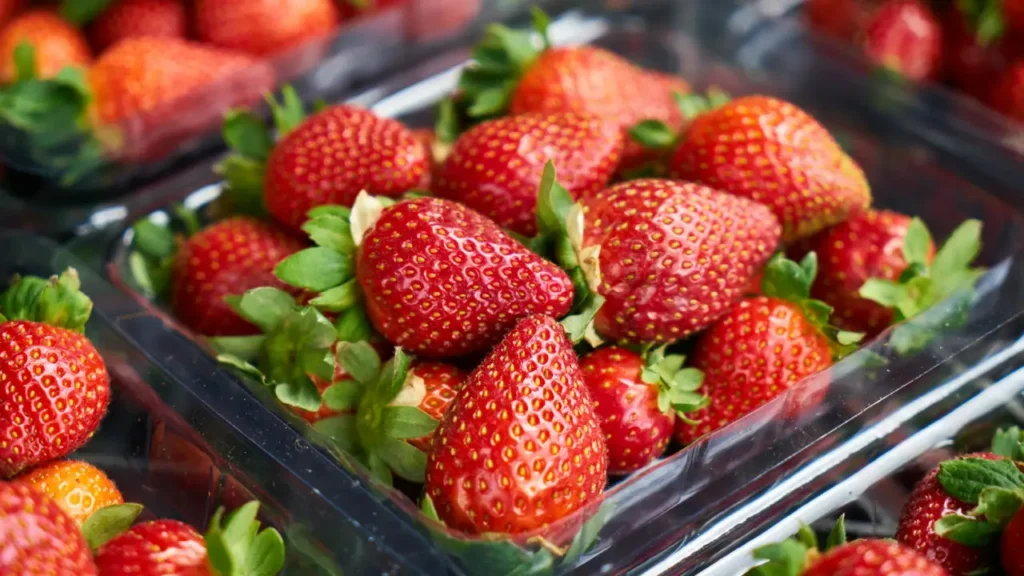
Proper Techniques for Washing and Prepping
Cleaning strawberries well is a fundamental process necessary for the safe storage or consumption of them which should be done carefully just the gentle rubbing under running water to get rid of the soil or microorganisms on them. According to the USDA post-harvest rules, a thorough rinse under cold water should be done first as the best method for cleaning, followed by patting the berries dry using a soft cloth or a paper towel. This method avoids additional water absorption which is one of the reasons of rapid spoilage.
Storing Strawberries to Extend Shelf Life
The storage conditions and times for the berries are very important to maintain their shelf life. Try to keep your berries in the cool and similar moisture controlled area. The predetermined temperature for strawberry storage is 32-36 °F (0-2 °C). Humidity level must be zeroed to 90-95% to ensure the items are kept fresh without mold growth.
| Storage Method | Temperature | Humidity | Expected Shelf Life |
|---|---|---|---|
| Refrigeration | 32-36°F (0-2°C) | 90-95% | 5-7 days |
| Freezer (whole berries) | 0°F (-18°C) or lower | N/A | 6-8 months |
| Freezer (sliced berries) | 0°F (-18°C) or lower | N/A | 3-4 months |
Freezing and Preserving Your Berry Bounty
Frozen way is a useful for preserving strawberries for your later consumption. Peel the strawberries with the vegetable peeler and put them on the tray in a single layer. Once they are froze put them into freezer-safe bags and air-tight container. To preserve this item, the jams, jellies, and syrup will be the perfect thing to make since later your home kitchen will be equipped with them.
- Freeze whole for smoothies or dessert toppings
- Freeze sliced for quick use in recipes
- Make preserves to capture the berry’s peak flavor
Common Mistakes to Avoid When Growing Strawberries
The strawberry enthusiasts fantasize about their huge harvests of wild strawberries like they are their everyday thing but they may make mistakes like careless planting and management and hence, they cannot attain what they are desiring. Consequently, let us review some of these mistakes that shouldn’t be tolerated.
Overcrowding and Poor Planting Practices
The right growing methods are important since they are necessary if well-grown strawberry plants that are healthy and productive are to be realized. Overcrowding the plants is detrimental to the air circulation that can create fungal infections and berry quality might be affected. Below is a table highlighting proper versus improper spacing:
| Proper Spacing | Improper Spacing |
|---|---|
| 18-24 inches between plants | Less than 12 inches between plants |
| Rows spaced 3-4 feet apart | Rows spaced less than 2 feet apart |
| Adequate space for runners | Neglecting to account for runners |
Mismanagement of Water and Fertilizers
Healthy and stable strawberries require a balanced water and fertilizer management for their growth. If you over water plants, roots will drown leading to root rot, if you under water plants, they become stressed, reducing fruit quality. Furthermore, misapplication of fertilizer can either scorch the plants or let them deficient of nutrient. undefined
- Water deeply but infrequently to keep the root system strong.
- Apply mulch to hold soil moisture and weed out the plants.
- Do a soil analysis before fertilize to know the nutrients your plants needs.
- Use 10-10-10 fertilizer in post-harvest season (and in early spring) according to instruction of label.
Ignoring Signs of Pests and Diseases
Early containment of pests and diseases becomes crucial to the sustainability of strawberry fields. Neglecting the symptoms can undoubtedly result in the severe outbreak or wide range of diseases. This can lead to the destruction of the whole crop. Here’s what to keep an eye out for:
- Inspect regularly the plants looking for the visible signs of the disease like the spots on the leaves or fruit.
- Keep watch for pests among aphids, slugs, or spider mites which can be easily handled with organic control.
- Apply boundary rotation and cultivate resistant varieties as preventative measures.
Conclusion
With the final part of our detailed berry cultivation guide, we focus on several issues that matter to become successful in the strawberry gardening. Right from picking varieties that suits your taste and your skill in perfecting the timing of harvest, every single step plays a crucial role that grows you an abundant strawberry patch. We have made you confident with knowledge to prepare the soil, to apply water and fertilizers correctly, and to defend the plants from the different pests and diseases. Eventually, by interpreting these learning experiences, you will be on your way to relishing your own gardening accomplishments with a fresh-from-the-yard harvest.
Do not fret that none of the usual combinations of an exotic variety of today’s taste might be a long way behind compared to the sensation that you get after slicing the fresh-break rip fruit which you have grown. These techniques – from organic methods to smart planning – that you will soon start applying will definitely create the circumstances that not only will lead to your garden becoming vibrant, but also exactly the ones similar to Eco-conscious principles. At the end of the procedure, you will feel excellent when you come across that strawberries up-cropping and end up with nothing but satisfaction in knowing that you just ate those strawberries for a long time.
Hopefully we have managed to give you the skills to cultivate your strawberry paradise. Your pathway to a rewarding and productive strawberry field begins with just a piece of soil. Well, get your gardening tools ready and make an adventurous beginning! You just need to experience the taste of our lovely green strawberries.
Must Read : How to Grow Tomatoes at Home
FAQ – How to grow strawberries Queries Answered:
When is the best time to plant strawberries in the USA?
The time best for planting strawberries differs depending on the place you live and weather of that region. In most regions starting planting in spring early or summer late to early fall will suit well. This maintains the agriculture constant ahead of the extreme temperatures to attain a better yield during the next harvesting season.
How often should I water my strawberry plants?
Strawberry plants should be watered according to schedule so that the moisture in the soil does not completely evaporate to keep the fresh growth going. Sprinkle deep water on your plants once an entire week in a week, better days await, or in one to two inches that assess the current weather and soil soil less conditions. The excess moisture can be a contributor of root rot or other diseases therefore over watering should be avoided.
Can I grow strawberries in containers?
Definitely, strawberries can easily be cultivated in pots or hanging baskets that are therefore perfect for small yards or city gardens. Select dwarf and trailing cultivars that can be grown in containers bearing in mind sufficient drainage. Give sufficient sunlight, water and fertilizers for strong growth and fertile fruits.
What are some common pests that affect strawberry plants?
Some as the commons pests often aphids, spider mites and slugs. In doing that, regularly check up your plants and use organic solutions like neem oil to prevent pests.
How do I know when strawberries are ready for harvest?
Picking strawberries when they are completely ripe, shiny deep red while still carrying a scent and slightly soft to the touch is preferred. Mostly ripe strawberries comes off easily from its plant with a slight twist. Picking strawberries at the top during the peak season will enable you to taste delicious strawberries of sweet flavor.
How much sunlight do strawberries need?
Strawberries are accustomed to direct sun and require at least 6-8 hours of sunlight daily for the optimum growth and fruit yield. Seeking a sunny spot for your strawberry planting to have good strawberry plants and large harvests.
What type of soil is best for growing strawberries?
Strawberries are suited to conditions well-drained soil that is only slightly acidic and should have a pH valued between 5.5 and 6.5. Mix heavy or clay soils, with bulky organic matter like compost, well-rotten manure, or peat moss so that your soil structure and fertility will improve after that. Ensure a dirt drainage so as to eliminate water gathering and prevent root rot.
How do I store and preserve excess strawberries?
Always keep freshly picked strawberries in the fridge in a shallow container with paper towels beneath them to absorb extra water. Do not rinse strawberries before eating, it will rot unusually fast instead. Even now it is possible to save the excess strawberries simply by freezing, canning or making jams and preserves.
How long do strawberry plants live?
Usually strawberry plants are productive for 3-5 years, although this time can differ depending on the growing conditions, variety and maintenance. After several years, the strawberry plants may appear to be less active and productive, prompting replanting with new plants or runners.
What are some effective strawberry gardening tips for beginners?
Beginners need to select according to their preference and type of climate and also need to prepare the perfect place with well drained and fertile soil or their plants for light and watering.
How do I prepare my garden for planting homegrown strawberries?
Test the soil’s pH and nutrient levels, if amendments are needed to improve the soil quality than you need to add them, arrange your strawberry beds for the best space occupancy and gather the necessary planting and maintenance tools and equipment.
What is companion planting and how can it benefit my strawberry plants?
Gardening with one another means growing selected plants side by side that can bring reciprocal benefits such as pest and disease control, or more effective pollination. An between strawberries with marigolds for pest deterrent while borage for pollinator attraction is also very welcome companion.
Can I grow strawberries using organic methods?
Absolutely! You can achieve organic strawberry production by using natural soil amendments like compost or organic pest and disease control methods that do not use synthetic chemicals.

